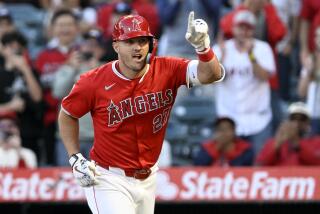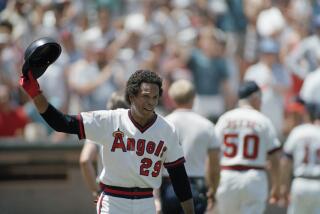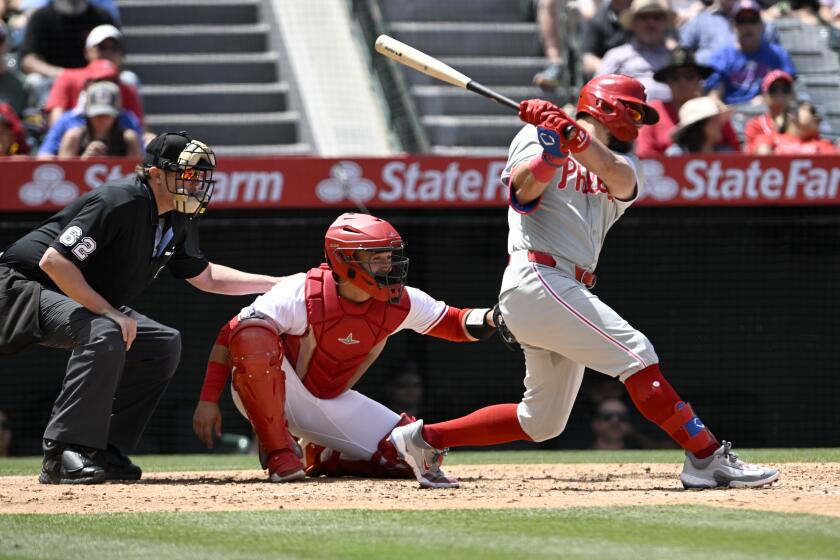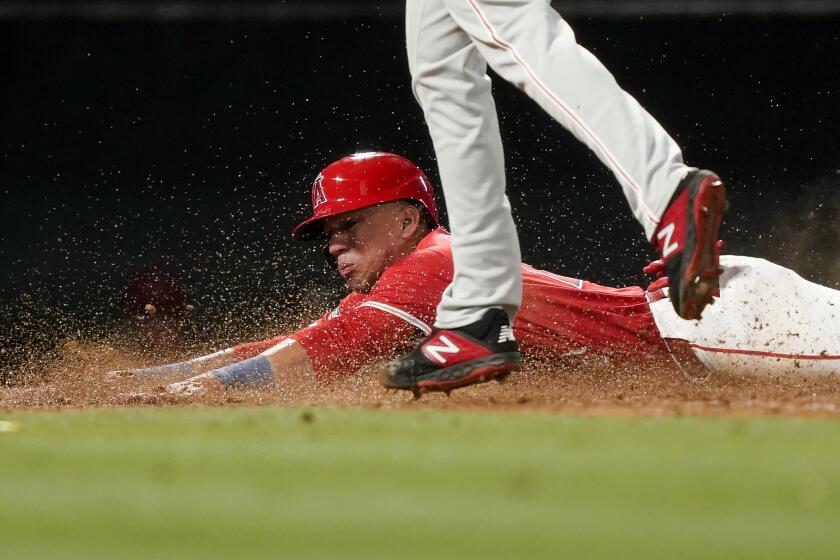Count quality, not pitches
May the spirit of the tough-guy old-timers rain down on baseball once more.
I write this while thinking about the brothers Weaver, Jered and Jeff, scheduled to take the mound in Anaheim today in an interleague, intrafamily duel.
I write this watching Chad Billingsley scuffle through six innings, looking at the end like a marathoner at mile 25.
I write this because baseball has become a game of diced-up stats and front-line pitchers who tremble once they’ve reached 100 pitches. The overarching subject here is pitch counts. And the Weavers figure in the conversation because the Dodgers’ Jeff has had a workhorse career where years of immense production have been followed by years of disaster.
Did the older Weaver throw too much, too soon?
This is a question Anaheim’s team is assiduously trying to avoid. As we see with iron-clad regularity throughout baseball, the Angels have taken a cautious approach to younger brother Jered, who at 26 is on the cusp of becoming a first time All-Star. Every fastball and funky sidearm twister gets tallied. Add up too many on a given day and it’s “Kid, thank you much, now hit the showers.”
Consider last Monday against San Diego: The eighth inning just ended and Weaver goes to the dugout three outs from his first complete-game shutout.
“Can you get it done in eight pitches?” asks Manager Mike Scioscia, knowing Weaver had already made 113 pitches -- which is where old-time toughs such as Nolan Ryan would have been just settling in the zone but about a dozen pitches past the number where modern managers start furrowing their brows with worry.
Luckily for Weaver, he gets his chance. Six pitches later, he has the win, 6-0.
On Friday at Angel Stadium, looking back on that game, Scioscia said he wouldn’t have been a complete stickler if Weaver had wobbled a little past his allotted eight. But had that wobble turned into a complete tilt? “Different story,” he said, “you are not going to be throwing 130 pitches. That would have been too much of a risk.”
Funny, isn’t it, how time and the insinuation of modern life -- stats and graphs and net-fueled probability theories -- change everything. For the Dodgers, of course, Scioscia played for the decidedly old-school Tom Lasorda, who let his pitchers hang on until their arms fell off. Scioscia also teamed with Fernando Valenzuela. “They didn’t have pitch counts back then,” Scioscia said with a laugh. “What did Fernando Valenzuela ever care about 130 pitches? The thing is, you have to have balance and that’s why we view the pitch count as another bit of good information. It’s just a tool.”
Too much of a tool? The Angels are hardly the worst offenders -- let’s be frank, overall Scioscia does a masterful job giving his pitchers space -- but in baseball as a whole it’s a different story. These days, a starting pitcher throws six innings, gives up three runs and it’s called a “quality start.” He goes more than six and the next day the guy’s agent is sending angry texts to ownership, complaining his pitcher is being treated like a piece of meat. He makes it to 110 pitches and almost invariably the wheels start spinning off, as happened to Billingsley against the Angels on Friday. (He made it to 112).
Yes, there’s a gray area here. There’s an art to when a pitcher should be pulled that takes into account his history of injury, how smoothly he has progressed through a game, how well he rebounds from tough games. I just worry that in too many cases the art is being tossed by the wayside. Hard numbers hold too much sway.
Larry Bowa agrees. The Dodgers’ third base coach, famously tough, sneered when asked about pitch counts. “I don’t like ‘em,” he said, noting that he’d make some exceptions for young players and whippet-thin ones. “This stuff is hurting the game. These guys get to 100 pitches and they start looking for help. They don’t know how to pitch out of a jam or bring home the win.”
Dodgers pitching coach Rick Honeycutt hardly hid his thoughts either. He called this a problem deeply woven into modern baseball, one that’s awfully hard to stop at the major league level. “You get guys like Chad Billingsley and Clayton Kershaw and they’ve been on a pitch count since the minors,” he said. “They’re 24 and 25 and it’s hard to get them off it.”
Things won’t ever go back to the way they used to be, nor should they. But Honeycutt said baseball can move in a more balanced direction if jolted by a successful team that goes against the grain. Down in Texas, in his second year as president of the Rangers, Ryan is trying to do just that. His mantra, from the minors on up: toss the pitch counts to the side -- let the pitchers show their stuff.
Said Honeycutt: “You’ve got to have a guy like a Nolan Ryan saying ‘enough of this stuff, there’s no reason in the world these guys can’t go 120 pitches. No reason at all.’ A guy like Ryan, maybe he can shock the world.”
Here’s hoping the Rangers taste that kind of success -- just so long as they don’t have too much of it against their division rivals. After all, we’d like to see a Dodgers-Angels reprise in the World Series.
--
More to Read
Go beyond the scoreboard
Get the latest on L.A.'s teams in the daily Sports Report newsletter.
You may occasionally receive promotional content from the Los Angeles Times.







